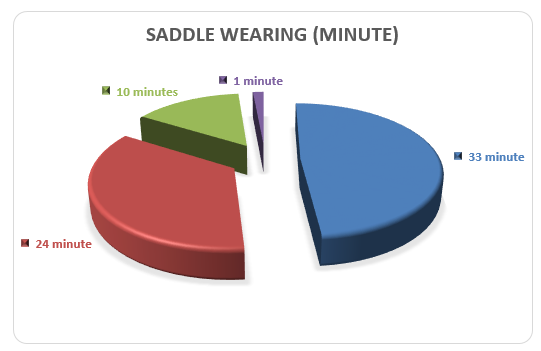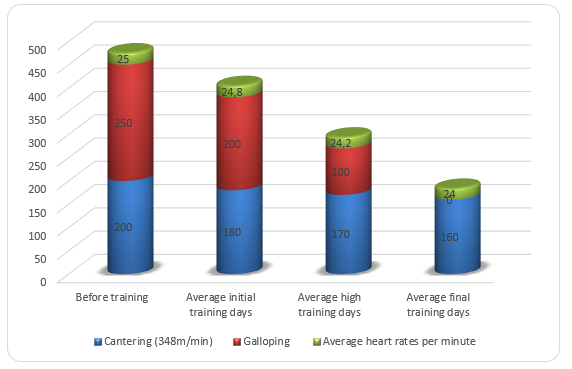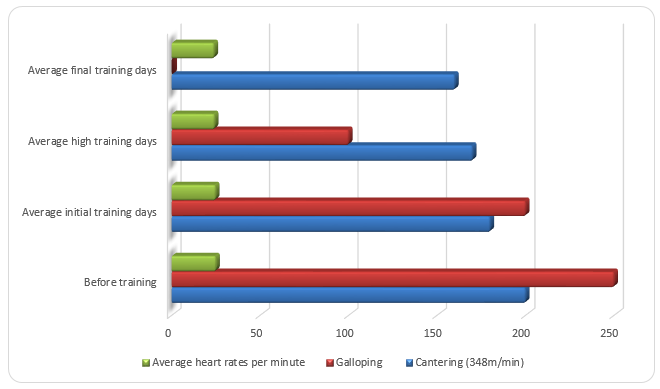Description
The participant in the reinforcement training is a male horse called Joy. Joy is black in color, aged seven years, and belongs to a neighboring farm. The animal has never been trained and the owner locks it in an old barn when others are in the field training or grazing. However, the horse has special abilities. For instance, Joy can race at cars speed and jump over set barricades at ease. Moreover, it has an athletic figure, and is extremely alert. Besides, the horse is tall, has a developed neck, and a small head. Additionally, horse’s eyes are protruding, it has large nostrils, and a small muzzle. Lastly, horse’s stamina and liveliness portrayed how indefatigable it is. In fact, what strikes about the horse is Joy’s curiosity. Joy is always snooping and exchanging glances with other horses whenever they meet.
Target Behavior
The owner wanted the horse to become more cooperative when carrying loads. As a result, reinforcement techniques could help the owner and the horse to utilize the horses special body features well. Consequently, the following study analyzes the effects of reinforcing horse abilities as a method of making an untrained horse more cooperative and less resistant to carrying loads. Moreover, the study outlines how to make horses more friendly and when they become sociable, they get easier to transport, sell to another owner, and participate in various activities such as recreational or leisure without putting themselves or a rider in danger.
However, nearly all horses have some uninviting behaviors and it is the role of the trainer to ensure they get calm because they learn best when less reactive. Furthermore, trainers have to help the horse scrap wariness, avoid generation of flight stimuli and fear reactions that could make any horse hard to control. Moreover, the act of loading a horse predisposes it to disease and long-term stress, which are unhealthy to horses (Pohjola 34).
Interventions
The first intervention measure was to enhance the horse interaction with humans. Since there is a relationship between repeated interactions of a horse and human, repeated exposure of the animal to human helped change horse’s attitude toward humans. As a result, after establishing friendship with the horse, individual introduction of stranger to the horse followed. Then, he was introduced to a small crowd and slowly the horse got used to standing in front of huge gathering. Moreover, in order to achieve a positive result, the animal needed rewarding after the training session or during the hardest session. In fact, introduction of sugar enhanced an everlasting memory whenever the horse was to repeat the same course.
Secondly, interventions involved helping the horse to fight fear through accustoming the animal to the current environment. For instance, it involved avoiding negative interactions that could make the horse distrust its handler. Hence, this was a way of enhancing the animal’s loyalty to the owner. A good example is the increased trust the horse had on me, the animal even relished and always got curious about the new learning (Gibbs et al. 12).
Behavioral Measurement
Various tools came in hand when determining the extent or rate of the horse adaptation to the new things during training. These tools included a stopwatch to measure the duration the horse bucked on wearing a saddle. The stopwatch was activated when a saddle was placed on the horse back and stopped when he stopped bucking. Loading test was used severally and the heart rates recorded every time the horse was carrying loads. To measure the heart rates, a stethoscope was placed on the area behind the left elbow of the horse. Thia measuring procedure included a heart rate belt tied around the horse’s chest together with a runners GPS watch to record the data. (Pohjola 1).
Results
The following is the summary record of the horses performance before training started and progressively during the training schedule.
The above table shows that the rate of horse bucking when worn the saddle reduced with continued reinforcement process as shown in the following pie chart.

It is clear that a trained horse can load more quickly than untrained. In fact, during training, the average time of loading decreased by fifty percent. The average loading rate can be show in the below graph.

Additionally, a trained horse shows low fear related signs and resistance to carry loads. In our case, the rate of trained horse galloping is less than twenty percent. Moreover, the heart rates of the trained horse averaged at twenty-four while that of untrained horse averaged at twenty-five. The above information can be summarized better by the below graph.

Summary and Conclusion
Effective handling of horses reduces the chances of their misbehavior. It also helps them to become relaxed when carrying loads and thus lowers the risks to the handler or themselves. Additionally, reinforcing behaviors enhance positive effects as the horse learns how to carry loads and becomes mild after training. Besides, with reduction of heart rates when interacting with human, a horse’s health is improved. As a result, the potential in reinforcing behaviors improves the health and life span of a horse (Pohjola 35).
Moreover, the reinforcement of behavior was done to already existing feature of the horse (Gibbs et al. 14). As a result, behavioral reinforcement improves characters or abilities and need to be studied before training begins to determine the right method of reinforcing those behaviors.
Works Cited
Gibbs, P., Potter, D., Nielson, B, Householder, D. & Moyer, W. Texas and University Department of Animal Science Equine Sciences Program. Scientific Principles for Conditioning Race and Performance Horse. Web.
Pohjola, Jaana. The effects of positive reinforcement training on horses loading behavior. 2011. Web.